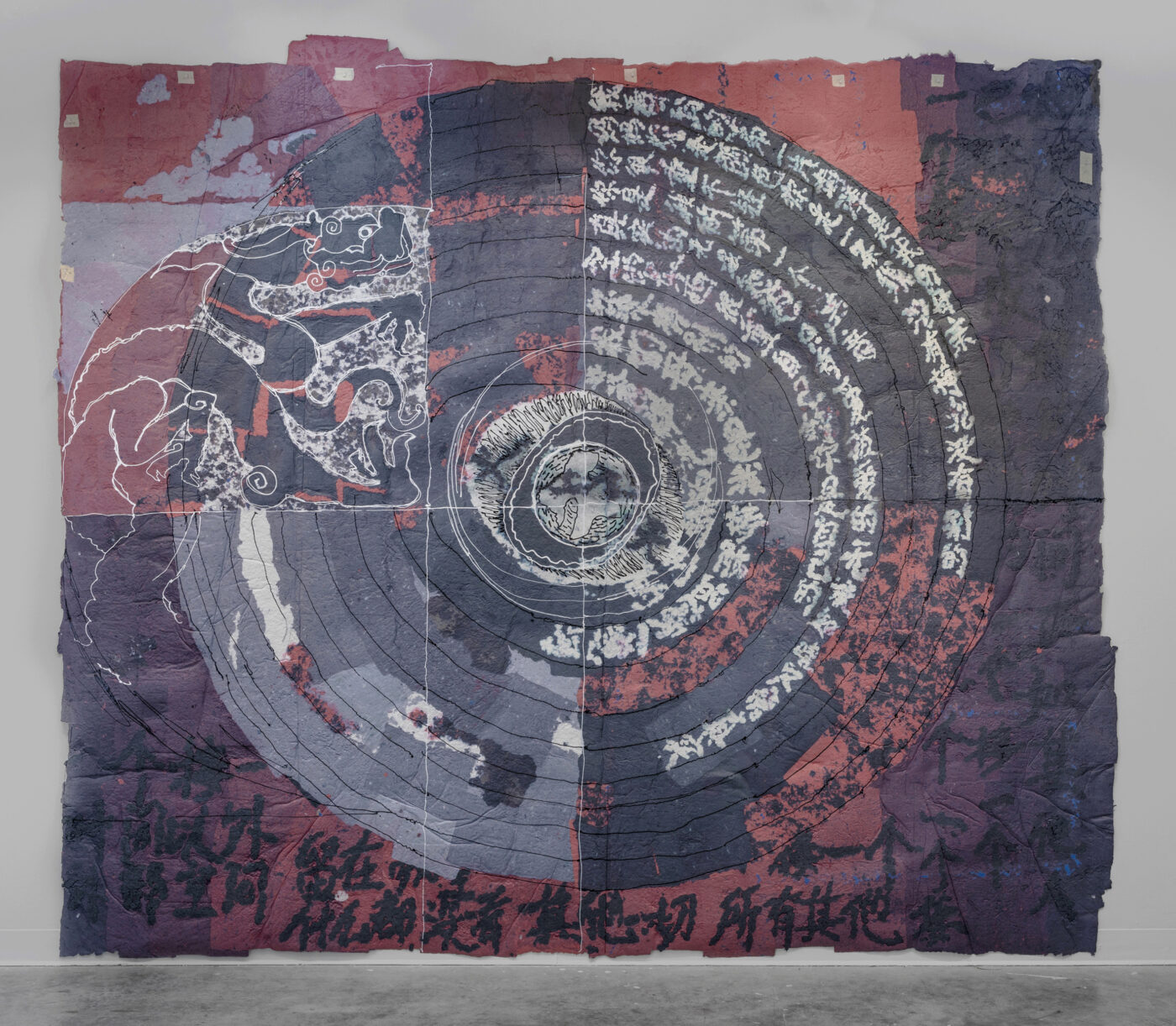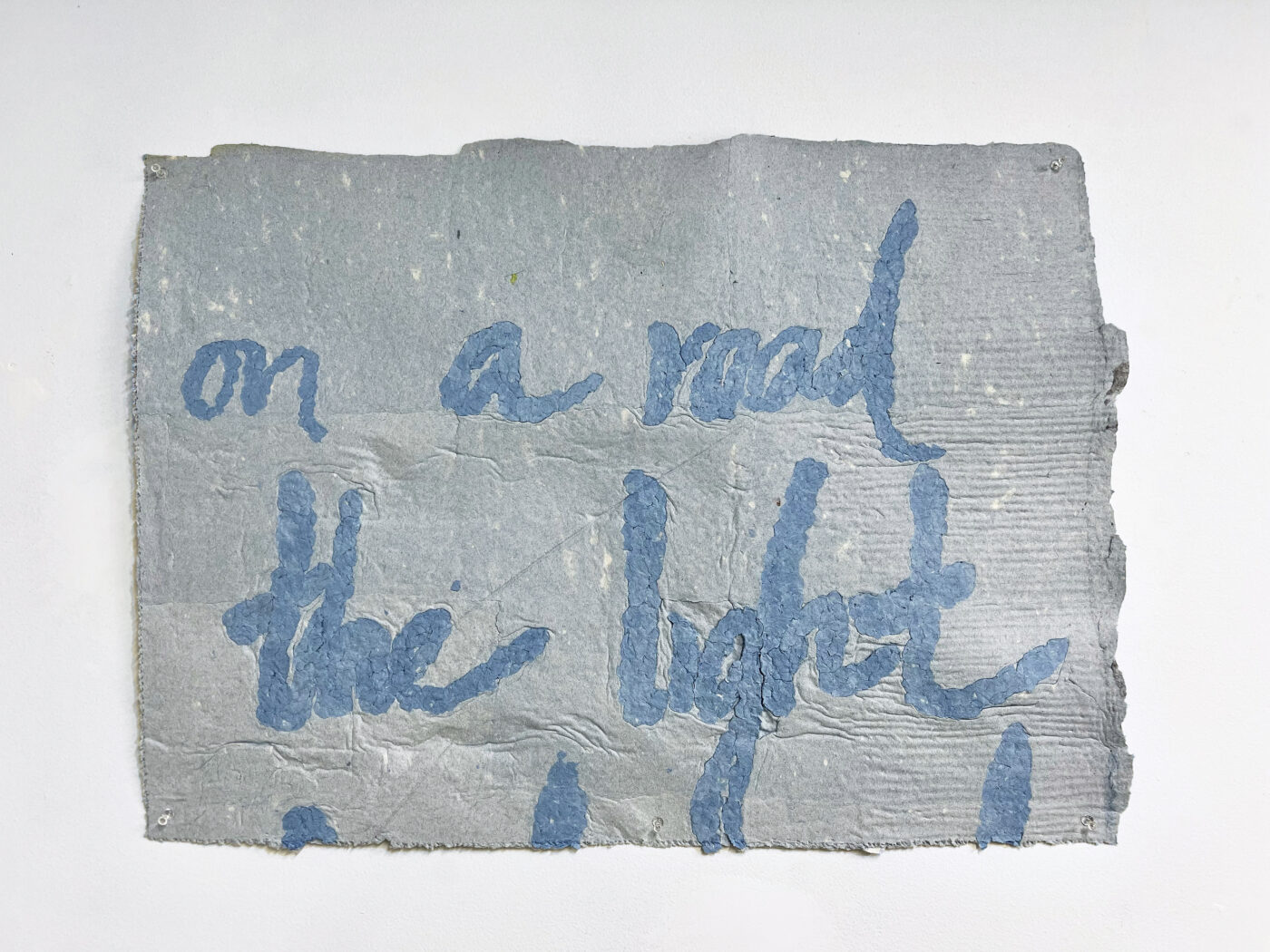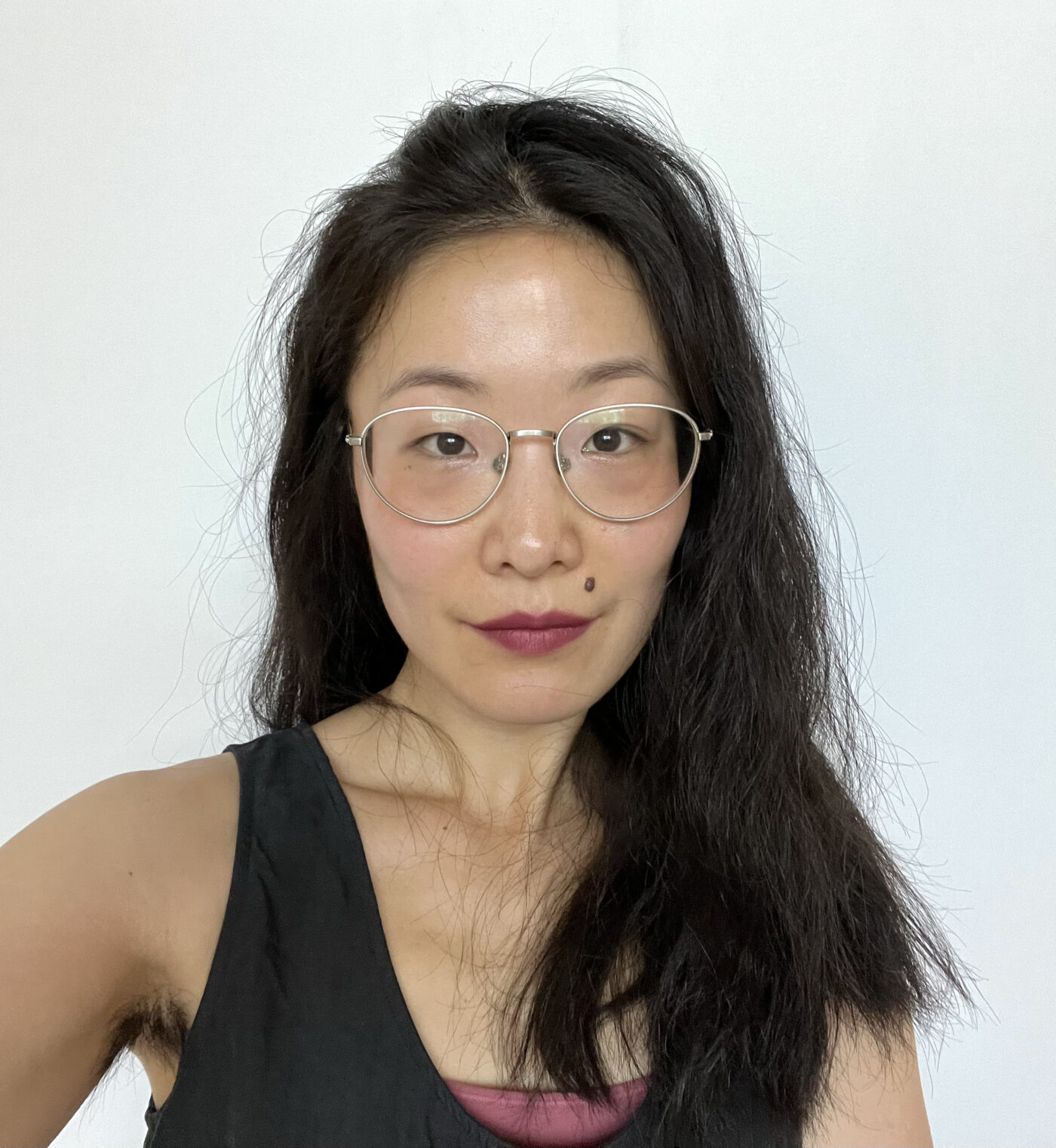


“There is nothing new under the sun, but there are new suns.” —Octavia Butler

4–5 minute experience, or the time it takes to peruse a photo album.
For artist Hong Hong, the process of painting generates knowledge that is fully felt, but not necessarily easily transcribed into language. Driven by a longstanding interest in wayfinding through paper pours that take the form of site-specific performances over the course of a full day, Hong’s work is an ongoing exploration in how to hold time. Here, she shares three new pours and what she learned while making them, ruminates on the tension between control and release, and encourages us to attune with our environment in order to better understand ourselves.
A Q&A WITH HONG HONG

[ID: A large, mixed-media painting made with hand-formed paper, calligraphic text, and paint. The background is a series of reverberating circles composed primarily of black and red stripes. There is a mixture of Chinese characters, a rendering of a dragon, and lines moving the foreground and middle-ground sporadically.]
Jessica Ferrer: How do your artworks function as samples of space-time or their environment?
Hong Hong: I’ve always been interested in navigation. It has to do with knowing where I am situated within space and time. Location affects what is proximate to my body, the things I can or cannot reach. This can be complex for a diasporic body that is caught between languages, continents, memories, and phenomenological experiences. I often think: I am not there, because I am here; I am here, but I am not present. I’m somehow in this world and not of this world. I started working directly in the landscape as a way to connect to and understand my surroundings.
Each painting is made with materials collected from a distinct area. As these substances cure, foliage and debris from the environment fall into and become a part of the painting. Passing weather registers as ridges, valleys, holes, and tears across its surface. Each sheet transcribes a particular place at a specific moment in time.

[ID: A small painting made of handmade paper. Darker blue pulp is shaped into the words “we live sometimes” against a lighter faded blue background flecked with bleachy white and weather-wrinkled by the environment it dried in.]
I started working directly in the landscape as a way to connect to and understand where I am. Each sheet of paper is made with materials collected from a specific place.
Jessica: How and when are your senses activated during the process of making paper? How might the finished work preserve or render those feelings?
Hong: The process of making the work is physical. I use my body to bend, lift, turn, push, lower, release, and empty. These activities show me that there are some things that only my body can know. The movements live inside of me, like a memory or a premonition. In many ways, it is about the phenomenology of the body, rooted in its gestures and sensations. I can’t access this type of knowledge with my intellect. The substances, while wet, are malleable and open to my touch. Through shifts in texture, color, and boundary, they document moments when my body behaves in ways that cannot be accounted for via language, when I cannot speak what I sense and feel.
The process of making the work is physical. I use my body to bend, lift, turn, push, lower, release, empty. These activities show me that there are some things that only my body can remember.

[ID: A small painting made of handmade paper. Darker blue pulp is shaped into the words “on a road the light” against a lighter faded blue background flecked with bleachy white and weather-wrinkled by the environment it dried in.]
Jessica: With these two new works, I can see what you mean: the surface’s folds, wrinkles, and flecks ground the piece in time. That being said, I’m not sure I’ve encountered work from you before that had legible text in them. Where did these words emerge from and how does the text relate to the materials you used to hold them?
Hong: Language involves a long process of naming. It’s a way to organize and superimpose a diagram of my feelings and beliefs onto the sometimes indifferent circumstances which caused them. Writing, like painting, is rooted in the relationship between figure and ground, being and time. Ultimately, this is a question about identity, our own as well as the world’s. I used to think that I wrote in order to arrive at the truth. A truth about myself, and about the work. But now, I recognize that it was a way for me to go back: to see something again, and to know it differently. For me, language spans infinite presence and infinite return: it is how I tried to carry a vanishing world with me.

[ID: A horizontal wooden frame, clamped together on all sides, rests atop cinder blocks in a gravel-covered clearing outside. The structure is filled with colorful pigments, debris, soil, foliage, and water collected from Lake Michigan. These substances are drying slowly in the sunlight.]
Jessica: I appreciate the way your process seems to balance a desire for control alongside a need to surrender. There’s the initial set-up, which you define, but then there’s an opening for your surroundings to participate and leave their mark. With this 12-hour performance at the edge of Lake Michigan, what did its waters share with you during and after the pour?
Hong: I walk to Lake Michigan every day. I’ve been considering large bodies of water in relation to interiority and memory. It’s impossible to have a static experience with the lake because it is fluid and constantly shifting. Consciousness is the same: present and porous; and yet, completely impenetrable.
In terms of my work, I always remember the fact that all the water has to fully evaporate before the disparate substances I’m working with can be lifted as a cohesive surface. Water is a necessary part of papermaking, but it is absent from the final object. There’s a kind of loss or dissipation that’s involved in metamorphosis. In the end, something essential is always missing.

[ID: A Chinese woman with silver spectacles and long hair looks into the camera. She is wearing a dark gray tank-top and stands in front of a white wall.]
Hong Hong
She // Her // Hers
Beverly, MA
Hong Hong goes outside every summer to make beneath the sky. In this largely nomadic practice, monastic rituals and painting combine with ancestral methods found in Chinese paper-making. Each work is a performance that begins at dawn and ends at dusk: it centers the birth and death of a single day. Hong is interested in the consideration and excavation of the diasporic body in relation to time, site, and divinity. These projects have been presented in solo and group exhibitions at Sarasota Art Museum (Sarasota, FL), Real Art Ways (Hartford, CT), Crystal Bridges Museum of American Art (Bentonville, AR), Fitchburg Art Museum (Fitchburg, MA), Ortega Y Gasset Projects (New York, NY), NXTHVN (New Haven, CT), Tiger Strikes Asteroid (Los Angeles, CA), Lawndale Art Center (Houston, TX), Akron Art Museum (Akron, OH), and Texas Asia Society (Houston, TX). Hong has received support from United States Artists, the Pollock-Krasner Foundation, MacDowell, Yaddo, Houston Center for Contemporary Craft, and McColl Center for Art + Innovation, among others.
honghong.studio
Instagram: @honghongstudio
